Hello, lovely readers! Imagine walking into a living room that instantly feels warm, vibrant, and full of character. That’s the magic of Pipli Appliqué lampshades.
Originating from the small town of Pipli in Odisha, India, this traditional craft transforms ordinary fabric into dazzling patterns using colorful stitched designs.
Today, artisans are blending this age-old art with modern aesthetics, creating lampshades that not only light up a room but also add a touch of culture and personality.
Whether you prefer subtle elegance or bold statement pieces, Pipli appliqué lampshades bring charm, color, and a handcrafted story to every modern living space.
History of Pipli Appliqué Craft
Pipli Appliqué, also known as Chandua, is a traditional Indian handicraft that has stood the test of time. Its journey from temple rituals to modern home décor is fascinating.
🌸 Origins of Pipli Appliqué Lampshades
- Rooted in Odisha: The craft originates from the small town of Pipli, near Bhubaneswar in Odisha.
- Temple Beginnings: Initially, appliqué work was created for religious purposes, particularly to decorate temples during festivals.
- Bright and Vibrant: The artisans used bold colors like red, yellow, and blue to create visually striking patterns for ceremonial canopies, umbrellas, and banners.
🏺 Cultural Significance
- Ritualistic Use: Traditionally, Pipli appliqué was used in religious festivals like Ratha Yatra, adorning chariots and deity decorations.
- Symbol of Devotion: Each motif and pattern was more than decoration—it represented spiritual beliefs and cultural values.
- Community Craft: Entire families in Pipli were involved in creating these works, passing skills from one generation to the next.
✂️ Evolution Over Time
- From Temples to Homes: Over centuries, the craft moved beyond religious use into household décor.
- Functional Art: Items like lampshades, wall hangings, cushions, and bedspreads became popular, retaining traditional designs while adapting to practical use.
- Introduction of Modern Shapes: Lampshades, in particular, became a contemporary canvas, blending classic motifs with functional design.
🎨 Techniques Preserved Through History
- Handcrafted Skill: Despite modernization, the traditional method of cutting, stitching, and layering fabrics has remained unchanged.
- Colorful Fabrics: Early artisans used cotton and silk with bright dyes, which is still maintained in modern lampshades.
- Intricate Motifs: Floral designs, geometrical patterns, and peacock motifs have been preserved, keeping the spiritual and cultural essence alive.
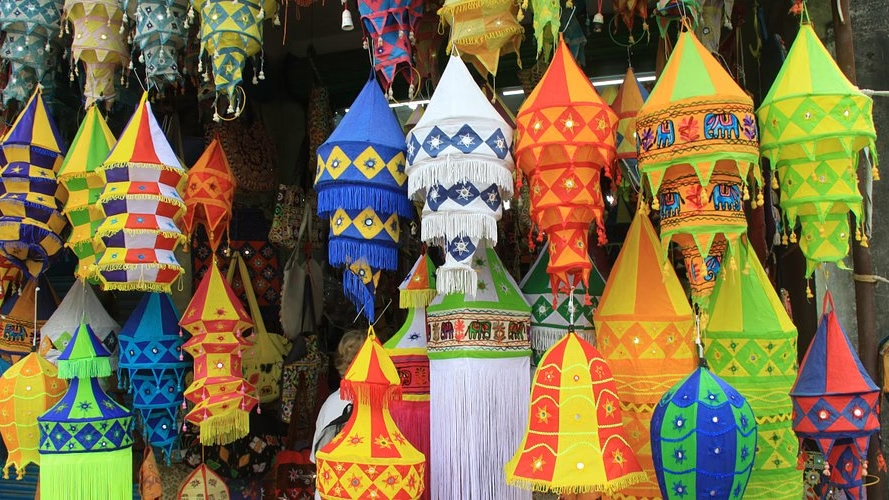
Materials Used in Pipli Appliqué Lampshades
Pipli appliqué lampshades are a stunning blend of tradition and contemporary design. Let’s explore its behind-the-making scenes in detail.
- Base Fabric
- Usually cotton or jute fabric is used as the base for lampshades.
- Cotton is soft, durable, and easy to shape, while jute adds rustic charm.
- Usually cotton or jute fabric is used as the base for lampshades.
- Colorful Fabric Pieces for Appliqué Lampshades
- Bright cotton or synthetic fabric pieces are cut into shapes such as flowers, leaves, birds, or geometric patterns.
- The variety of colors adds vibrancy to the lampshade and makes it visually striking.
- Bright cotton or synthetic fabric pieces are cut into shapes such as flowers, leaves, birds, or geometric patterns.
- Thread and Stitching Materials
- Strong cotton or polyester threads are used for stitching the appliqué pieces onto the base.
- Sometimes metallic or contrasting threads are used for decorative embroidery to enhance the design.
- Strong cotton or polyester threads are used for stitching the appliqué pieces onto the base.
- Lampshade Frame
- A sturdy wireframe or pre-made lampshade structure is used to hold the fabric in place.
- Frames come in various shapes—cylindrical, conical, or drum-shaped—to match modern décor styles.
- A sturdy wireframe or pre-made lampshade structure is used to hold the fabric in place.
- Glue and Adhesives (Optional)
- While stitching is primary, some artisans use fabric glue for extra support or to hold intricate pieces temporarily before stitching.
- While stitching is primary, some artisans use fabric glue for extra support or to hold intricate pieces temporarily before stitching.
- Additional Decorative Elements
- Mirrors, beads, sequins, or small tassels can be added to make the lampshade more ornate.
- These elements give the lampshade a festive, handcrafted feel while maintaining modern appeal.
- Mirrors, beads, sequins, or small tassels can be added to make the lampshade more ornate.
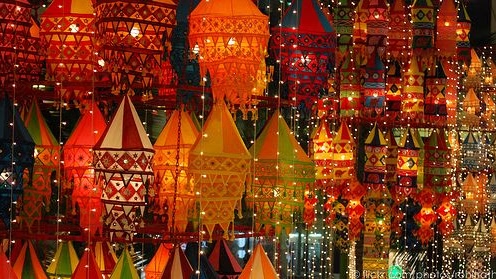
Step-by-Step Process of Making Pipli Appliqué Lampshades
Step 1: Designing the Pattern
- The first step involves creating the design on paper.
- Artisans decide on the theme—floral, geometric, or abstract—keeping in mind the colors and size of the lampshade.
- This sketch serves as a guide for cutting and placing appliqué pieces.
Step 2: Cutting the Base Fabric
- The cotton or jute fabric is cut according to the lampshade’s size and shape.
- Precision is important to ensure a snug fit over the lampshade frame.
Step 3: Preparing the Pipli Appliqué Pieces
- Small fabric pieces are carefully cut according to the design—petals, leaves, triangles, or circles.
- Edges of these pieces are often folded slightly to prevent fraying.
Step 4: Arranging the Pieces on the Base
- All appliqué pieces are temporarily placed on the base fabric.
- This step allows the artisan to visualize the final pattern and make adjustments before stitching.
Step 5: Stitching the Appliqué
- Each fabric piece is stitched onto the base using neat, small stitches.
- Hand-stitching ensures precision, durability, and a handcrafted finish.
- Decorative stitching, such as running stitches or satin stitches, enhances the aesthetic appeal.
Step 6: Attaching the Base to the Frame
- Once stitching is complete, the decorated fabric is carefully mounted on the lampshade frame.
- The fabric is secured evenly so that it sits smoothly without wrinkles.
Step 7: Adding Decorative Elements (Optional)
- Mirrors, beads, or small tassels are added as per design preference.
- These finishing touches elevate the lampshade, making it suitable for modern living rooms.
Step 8: Final Inspection and Quality Check
- The Pipli Appliqué lampshades are checked for any loose threads, uneven stitches, or fabric alignment issues.
- Only after passing quality inspection is it ready for sale or home décor.
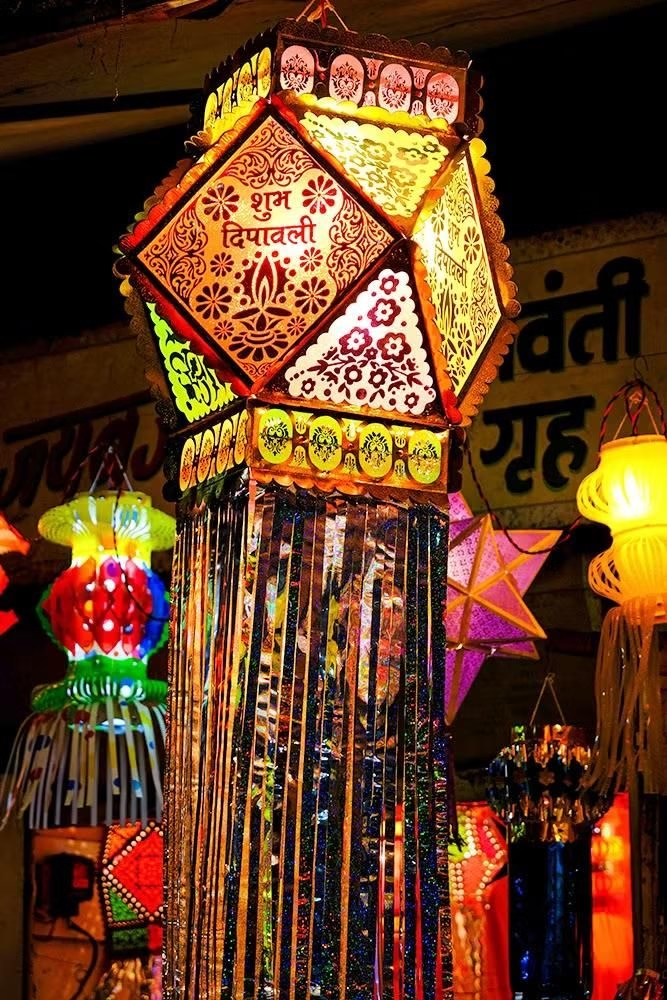
Symbols and Desings in Pipli Appliqué Lampshades
Pipli Appliqué is more than just colorful fabric work—it’s a visual story woven into patterns, shapes, and symbols. When these motifs are used in lampshades, they don’t just brighten a room; they bring in culture, tradition, and energy. Let’s explore the rich symbolism behind these designs.
1. Nature-Inspired Motifs 🌿
- Flowers and Petals
- Represent beauty, growth, and positivity.
- Popular in modern lampshades to create a vibrant yet calming ambiance.
- Lotus flowers are often used to symbolize purity and peace.
- Represent beauty, growth, and positivity.
- Leaves and Vines
- Symbolize continuity, fertility, and harmony.
- On lampshades, trailing vine patterns add a flowing, organic feel to modern interiors.
- Symbolize continuity, fertility, and harmony.
- Sun and Moon Patterns
- The sun represents energy, warmth, and life.
- Moon motifs are calming and signify serenity—perfect for soft lighting.
- Often embroidered in contrasting colors for a striking visual effect.
- The sun represents energy, warmth, and life.
2. Animal Motifs 🐘🦚
- Elephants
- Symbolize strength, wisdom, and good fortune.
- A Pipli lampshade with elephant motifs adds a sense of grandeur and cultural depth to a living room.
- Symbolize strength, wisdom, and good fortune.
- Peacocks
- Represent beauty, pride, and elegance.
- A bright, detailed peacock appliqué enhances the aesthetic appeal of modern décor.
- Represent beauty, pride, and elegance.
- Birds and Other Creatures
- Small birds indicate freedom and joy.
- Animals in Pipli work often reflect local folklore and connect the décor to nature.
- Small birds indicate freedom and joy.
3. Geometric Motifs 🔺⬛
- Triangles, Squares, and Diamonds
- Triangles symbolize stability and direction, squares for balance, and diamonds for prosperity.
- These geometric shapes are often repeated in borders or central panels of lampshades, giving a modern, structured look.
- Triangles symbolize stability and direction, squares for balance, and diamonds for prosperity.
- Circles and Spirals
- Represent unity, wholeness, and continuity.
- Spirals add a dynamic, artistic element that catches the eye in contemporary interiors.
- Represent unity, wholeness, and continuity.
4. Cultural and Religious Symbols 🕉️
- Traditional Folk Patterns
- Designs inspired by Odisha’s local festivals, dances, and rituals.
- Include motifs like conch shells, temple arches, and stylized human figures.
- Bring a storytelling element to a modern living room.
- Designs inspired by Odisha’s local festivals, dances, and rituals.
- Sacred Symbols
- Certain lampshades carry motifs like Om or the swastika (auspicious symbols in Indian tradition).
- They are believed to invite positivity and good energy into the space.
- Certain lampshades carry motifs like Om or the swastika (auspicious symbols in Indian tradition).
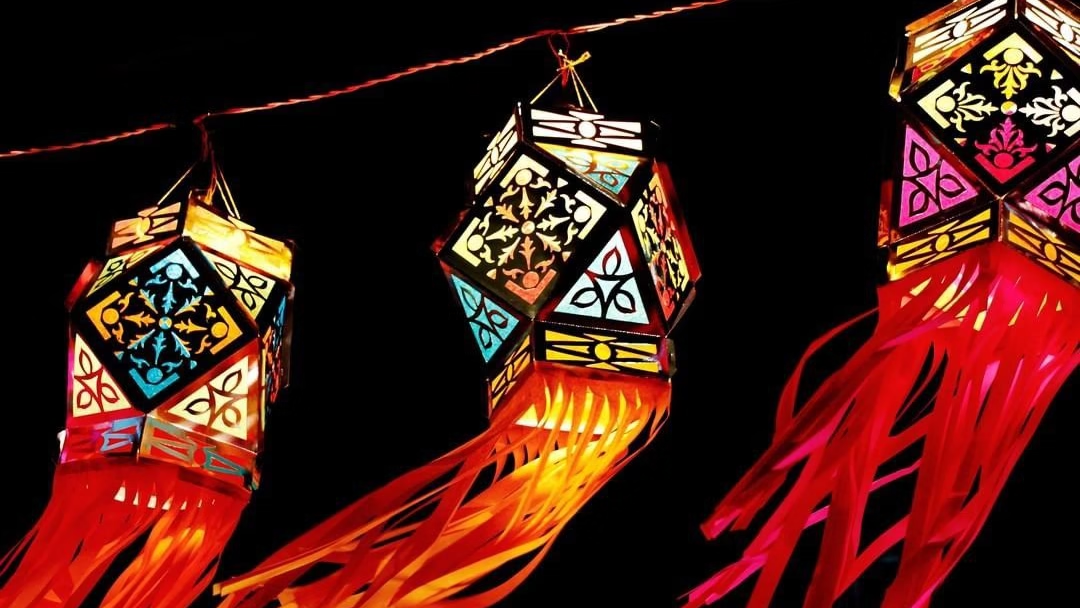
Why Symbols Matter in Modern Living Rooms ✨
- Blend of Tradition and Style
- Even in minimalist interiors, Pipli motifs add a cultural layer without overwhelming the design.
- Even in minimalist interiors, Pipli motifs add a cultural layer without overwhelming the design.
- Visual Storytelling
- Each symbol communicates heritage, nature, or positive energy—making the décor feel more personal and meaningful.
- Each symbol communicates heritage, nature, or positive energy—making the décor feel more personal and meaningful.
- Focal Point Creation
- A lampshade with intricate motifs naturally draws attention and can become the centerpiece of a room.
Impact on Modern Living Room Décor
Pipli Appliqué lampshades are more than just light covers—they are a fusion of traditional craft and contemporary interior design. Here’s how they are making a difference in modern living rooms.
1. Adding a Pop of Color and Vibrancy
- Bright Patterns: Pipli lampshades are known for their vibrant hues—reds, yellows, blues, and greens—that instantly brighten up any space.
- Contrast and Accent: Even in minimalist rooms with neutral palettes, a Pipli lampshade becomes a striking accent piece.
- Layered Decor: The interplay of multiple colors in one lampshade complements cushions, rugs, or artwork, creating a cohesive look.
2. Bringing Cultural Richness to Interiors
- Heritage Appeal: Each lampshade carries the legacy of Pipli’s traditional appliqué work from Odisha, connecting your home to India’s artistic roots.
- Storytelling Element: Motifs like peacocks, flowers, and geometric patterns act as conversation starters.
- Cultural Fusion: Even modern, contemporary furniture pairs beautifully with these ethnic pieces, creating a global-meets-local aesthetic.
3. Enhancing Ambiance and Mood
- Warm Lighting: The layered fabric allows soft, diffused light to pass through, creating a cozy and inviting atmosphere.
- Play of Shadows: Intricate cutwork and appliqué details cast subtle, decorative shadows on walls and ceilings, adding depth to the room.
- Relaxing Environment: Perfect for living rooms where families relax or entertain guests, giving a warm, homely vibe.
5. Eco-Friendly and Sustainable Décor Choice
- Handmade Craft: Each piece is handcrafted, supporting artisans and promoting sustainable practices.
- Natural Materials: Typically made from cotton and recycled fabrics, making them environmentally responsible.
- Slow Décor Movement: Ideal for homeowners who value conscious, handcrafted décor over mass-produced items.
6. Creating a Unique Focal Point
- Eye-Catching Designs: The colorful appliqué patterns instantly draw attention, becoming a centerpiece in the living room.
- Customizable Options: Many artisans offer personalized patterns, colors, or sizes to match your interior theme.
- Complementary Decor: Works well with ethnic rugs, wall art, or modern furniture, balancing tradition and contemporary design.
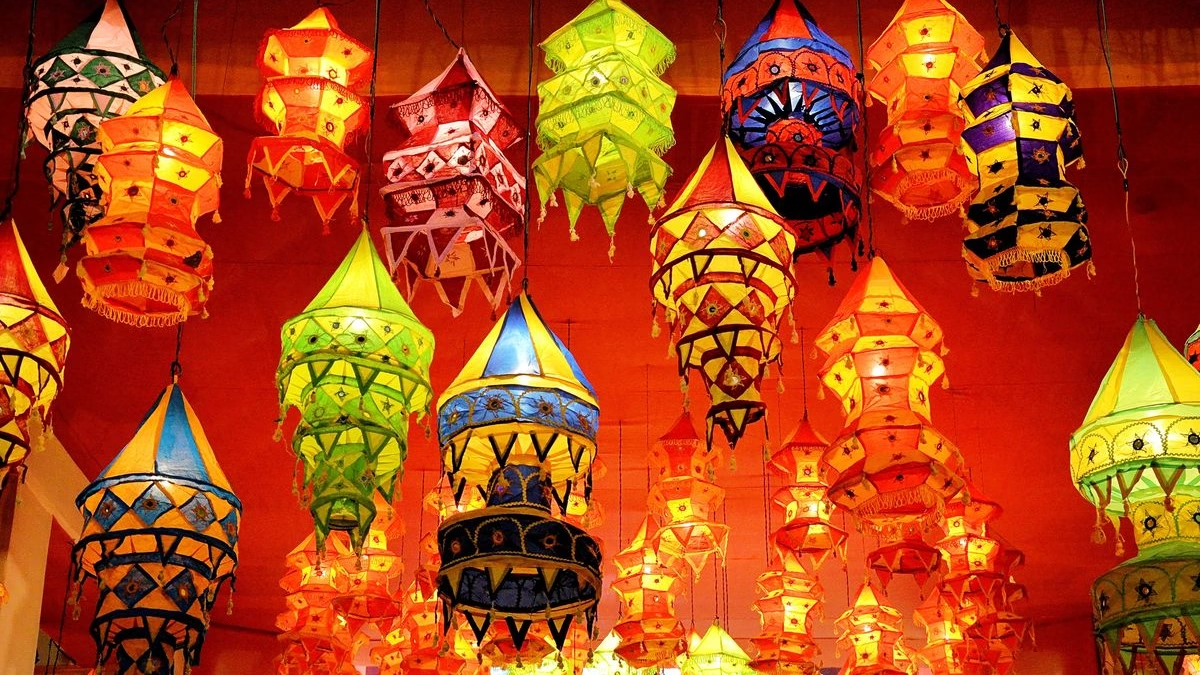
Statistics and Market Trends of Pipli Craft
Pipli appliqué work, traditionally known for vibrant textiles and decorative items, is now entering modern home décor, especially in lampshades. Understanding the statistics and trends helps us see how this heritage craft is adapting to contemporary living spaces.
1. Market Growth and Popularity
- Rising Demand for Handicrafts
- The Indian handicrafts sector is valued at over $35 billion in 2023.
- Decorative items like lampshades have seen a 12–15% annual growth, especially in urban markets.
- The Indian handicrafts sector is valued at over $35 billion in 2023.
- Global Reach
- Pipli appliqué items are exported to countries in Europe, the US, and Southeast Asia.
- Modern décor enthusiasts prefer handcrafted, sustainable lighting accessories, boosting Pipli lampshade exports by 10% annually.
- Pipli appliqué items are exported to countries in Europe, the US, and Southeast Asia.
- E-Commerce Influence
- Online platforms like Amazon, Etsy, and Flipkart have made Pipli craft more accessible.
- Nearly 60% of sales now come from online channels, with younger buyers showing strong interest in artisan-made décor.
- Online platforms like Amazon, Etsy, and Flipkart have made Pipli craft more accessible.
2. Regional Production Statistics
- Odisha’s Pipli Village
- Over 1,500 artisans are actively involved in producing Pipli appliqué items.
- Lampshades constitute about 20% of total Pipli craft production, showing a growing focus on functional décor.
- Over 1,500 artisans are actively involved in producing Pipli appliqué items.
- Employment Generation
- Each lampshade takes 2–4 days to create, providing sustainable income to artisan families.
- Around 300–400 families in Pipli depend partially on lampshade production for livelihood.
- Each lampshade takes 2–4 days to create, providing sustainable income to artisan families.
3. Trends in Design and Innovation
- Fusion of Traditional and Modern
- Traditional motifs like peacocks, floral patterns, and geometrical designs are now adapted to minimalist and contemporary lampshades.
- Color palettes are also evolving—muted pastels, monochrome designs, and metallic accents are trending.
- Traditional motifs like peacocks, floral patterns, and geometrical designs are now adapted to minimalist and contemporary lampshades.
- Customization Options
- Buyers now prefer personalized or themed lampshades for living rooms, encouraging artisans to innovate.
- Customization has increased revenue for small-scale Pipli businesses by 25–30% annually.
- Buyers now prefer personalized or themed lampshades for living rooms, encouraging artisans to innovate.
- Collaborations with Designers
- Interior designers are integrating Pipli lampshades into curated living room setups.
- This has expanded the market beyond traditional handicraft buyers to high-end urban households.
- Interior designers are integrating Pipli lampshades into curated living room setups.
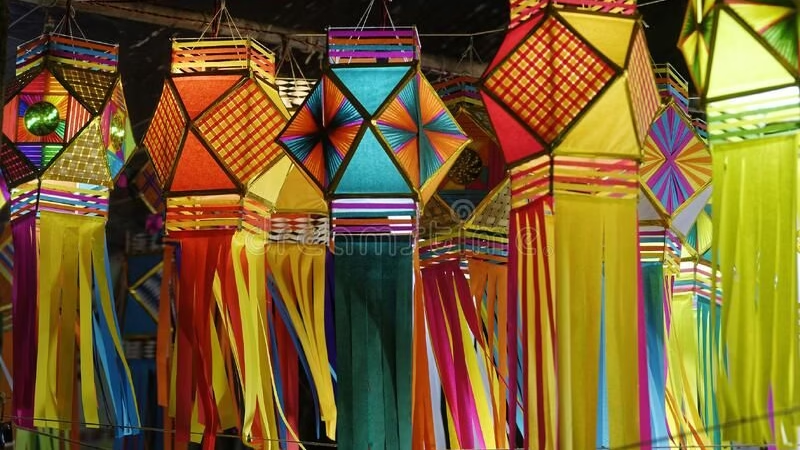
Care and Maintenance Tips for Pipli Appliqué Lampshades
Owning a Pipli Appliqué Lampshade feels like holding a slice of Odisha’s craft magic—colorful, quirky, and full of life! But to keep that handmade beauty glowing bright, a little TLC (tender loving care!) goes a long way. Here’s how you can pamper your pretty lampshade and keep it shining for years.
Keep It Dry and Happy
- No moisture, please! These beauties hate dampness. Water or humidity can make the fabric droop or fade.
- Place it in a dry, airy corner where it won’t soak up steam from your kitchen or bathroom.
Dust It Like a Pro
- Regular dusting is key. Just use a soft, dry cloth or a gentle paintbrush.
- Avoid sprays or cleaners—Pipli appliqué fabric is delicate and likes to stay natural.
Don’t Let the Sun Steal the Show
- Bright sun = faded colors. Keep your lampshade away from direct sunlight.
- If you love that sunny window spot, try a sheer curtain to tone down the rays.
Handle With Care (Like It’s Art… Because It Is!)
- When changing bulbs or moving it around, hold the frame, not the stitched fabric.
- The tiny threads and mirror work are fragile—treat them gently.
Give It a Cozy Rest Spot
- Not using it for a while? Wrap it in a soft muslin cloth to keep dust and moisture away.
- Store in a cool, dry place, away from sharp objects or anything that could snag the fabric.
A little care keeps your Pipli Appliqué Lampshade glowing bright and storytelling for years—because every stitch deserves to shine!
Wrap-Up Lines
So, folks, Pipli appliqué lampshades are more than just lighting accessories—they are a perfect blend of tradition and contemporary design. Originating from the vibrant craft villages of Odisha, these lampshades carry the skill, creativity, and cultural heritage of generations of artisans.
Incorporating Pipli lampshades into contemporary interiors allows homeowners to celebrate heritage while keeping their décor stylish and fresh.
Beyond aesthetics, these handcrafted pieces support local artisans and promote sustainable craft practices. Truly, they are a bright, cultural touch that modern homes deserve.
Also Read:- Lacquered Bamboo Furniture from Andhra Pradesh

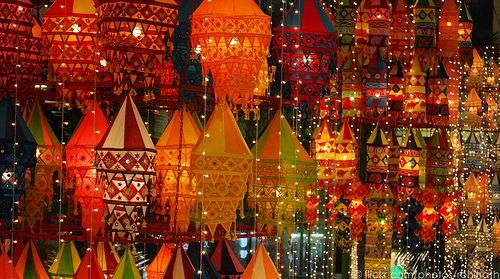
Leave a Reply